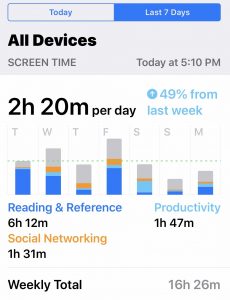CSP Team Note: This is Part 2 in a two-part series by Smarty guest blogger Scotty Sells, Sells Consulting that we first published in the Spring, but with Back to School staring at us, we think it’s SO important we wanted to repost it!
Apple’s Screen Time is a fantastic new feature to our iPads or iPhones that help monitor and control how much we use our devices. It’s so easy to hand our children these pacifiers and watch as they quickly turn into iZombies. But we all know they can quickly become quite attached (or shall I say addicted). If you don’t have the power to take your child’s device from them at any time, you’re doing it wrong. But that’s a discussion for another time.
You can use Screen Time without securing it with a 4 digit code just to get used what is has to offer. I strongly encourage all my clients to enable Screen Time on their personal devices first so they can better understand what data it gathers and controls that are available. That way, when they activate it on their child’s phone, they’ll have a better understanding of what to look for. One of the worst things we can do as parents is place restrictions on our children that we don’t fully understand ourselves. Using Screen Time for a few days or even a week is a great way to learn what it has to offer.
It’s good to think of Screen Time first in 3 separate user categories.
1. An adult just looking to watch their own phone use.
2. An adult (over 13) who needs some help with how much they use their device. A passcode can be placed on the device to enable limits.
3. A child (13 and under) whose parent will control usage.
A child’s device can be monitored just as in example two or it can also be monitored and changed remotely through the parents phone by using iCloud. You’ll have to have iCloud family sharing set up in order for the child’s device usage to be available on your own phone.
The issue here is the age 13. Apple has chosen 13 years old as the age where children’s parental controls do not qualify for remote control through iCloud. In this case, the parent must have the phone in their hands in order to check usage and make changes. I know. I know. Way too early! I hope they’ll push that up a little in the future.
Now let’s look at the 4 areas you can use to control usage. You’ll find Screen Time under the Settings on your iPhone or iPad. Those areas are as follow:
1. Downtime
2. App Limits
3. Always Allowed
4. Content & Privacy Restrictions.
Let’s discuss them slightly out of order. Downtime enables the user to control what time the phone’s access to almost all other apps gets shut  off. This can be set to something like after 10pm until 7am the next day for example. However, it’s important to realize this doesn’t shut off the phone completely. By default, three apps still function even when downtime is enabled. Those are the phone itself, text messages, and maps. In other words, your child could still text you, call you or find their way home after Downtime was enabled for the night if they were out on the town. You do have the ability to control those apps by removing those or allowing others. That brings us to 3. Always Allowed. Here you will find the entire list of all apps on the phone and you can choose to add any app to the list of allowed apps even when downtime is on. Pretty simple. Maybe your child takes Japanese and they want to cheat on their homework by using the Google Translate app but they waited until the last minute to tell you that their assignment is due tomorrow and it’s past time for bed. You can allow the Translate app to be accessible after 10pm.
off. This can be set to something like after 10pm until 7am the next day for example. However, it’s important to realize this doesn’t shut off the phone completely. By default, three apps still function even when downtime is enabled. Those are the phone itself, text messages, and maps. In other words, your child could still text you, call you or find their way home after Downtime was enabled for the night if they were out on the town. You do have the ability to control those apps by removing those or allowing others. That brings us to 3. Always Allowed. Here you will find the entire list of all apps on the phone and you can choose to add any app to the list of allowed apps even when downtime is on. Pretty simple. Maybe your child takes Japanese and they want to cheat on their homework by using the Google Translate app but they waited until the last minute to tell you that their assignment is due tomorrow and it’s past time for bed. You can allow the Translate app to be accessible after 10pm.
Now things get a little more complicated. 2. App Limits is a little too broad for my tastes. In this area it allows you to limit large categories of apps like “Social”. That tends to be a little too restrictive in my opinion. I suggest leaving this section alone and instead use another area to apply limits on an app by app basis. To do this, you’ll first need to enabled Screen Time for at least a few days so the phone has a chance to build a history of usage. After a few days, you can go into the main usage area at the top of the screen and select the details. This will then give you a break down in usage order as to what apps your child uses the most. You can then select each app individually and apply a limit to that specific app. You’ll quickly see your child’s habits. Instagram for 7 hours a week? Really? Looks like we have some work to do.
The 4th category, Content & Privacy Restrictions, is a revamp of the parental controls that have been on these devices for several years now. This category includes limiting adult content while browsing, age restrictions for the App Store, and control over what apps have access to location services. It’s easy to get lost or overwhelmed in Content & Privacy Restrictions but it’s important to remember something I touched on earlier. We have to realize that no matter what settings we apply to these devices, our children will find ways to see whatever they want. All we are doing here is trying to send the message of what each of our families deems appropriate or inappropriate. If you lock the phone, they’ll move to the computer. If you lock the computer they’ll move to the iPad. If you lock the iPad, they’ll move to the neighbor’s computer and so on. Going through every single setting in Content & Privacy Restrictions can be more than you actually need to do. It’s good to be familiar with what’s offered but you don’t have to necessarily have a mastery of that area right away.
You might notice a setting called “Share across devices”. This is a good idea to turn on if your child uses multiple devices like an iPhone and an iPad. Enabling this will allow for the parental settings to combine all usage across both or more devices. This means if you’ve limited your child’s use of Instagram to let’s say 1 hour a day, that means that the total time across all devices will be 1 hour cumulatively, not 1 hour per device. So this is a very important setting.
Depending on your parenting style, Screen Time gives you a lot of options and pathways to conversations you can have with your child on how much  time you think is appropriate per app or on the device in total. By using the 7-day chart, you have a visual aid to show your child how much time they’re using their device. Each family is different and there is no perfect setting. Your parenting style is your own. You may choose to only converse with your child while your neighbor may lock their child’s phone down like it’s got the nuclear codes. What I think we can all agree on is that it is a good idea to be aware of how much our children use these devices and from there, we can all parent as best we know how. Have questions? You can always schedule a session online at sellsconsulting.com, email me, or join me every Monday evening at 7pm for free at my Town Hall online help sessions.
time you think is appropriate per app or on the device in total. By using the 7-day chart, you have a visual aid to show your child how much time they’re using their device. Each family is different and there is no perfect setting. Your parenting style is your own. You may choose to only converse with your child while your neighbor may lock their child’s phone down like it’s got the nuclear codes. What I think we can all agree on is that it is a good idea to be aware of how much our children use these devices and from there, we can all parent as best we know how. Have questions? You can always schedule a session online at sellsconsulting.com, email me, or join me every Monday evening at 7pm for free at my Town Hall online help sessions.
About Scotty Sells
Scotty Sells taught in Charlotte-Mecklenburg schools for 15 years before moving to Apple. He then started his own consulting business working both in homes and businesses around Charlotte as well as remotely over the Internet. When he’s not sailing in Lake Norman or the Pamlico Sound, he tours the US playing steel drums for various groups. For more than 15 years Scotty has been helping both new and experienced users with technology as well as parenting best practices. For more info or to schedule a session you can visit www.sellsconsulting.com.





